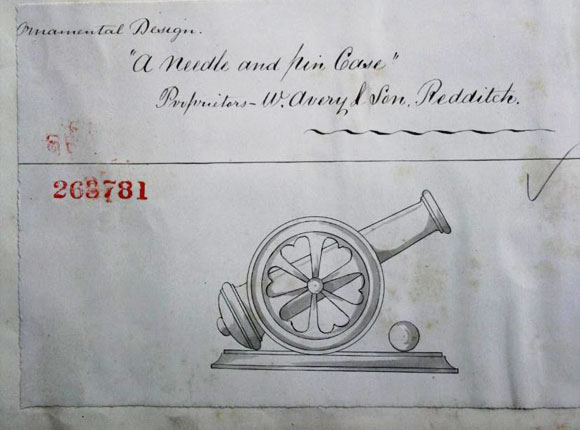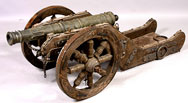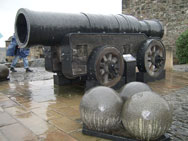Cannon
No example of this needle case has been found to date and it is unknown whether it was actually produced. If you have this needle
case in your possession or know of someone who has it, please contact us so that photographs of it can be
obtained and added to the this website.

Design Representation
Design Details
Needle Case Type: |
Figural |
Patent/Registered to: |
W. Avery & Son - Redditch |
Patent/Design Representation #: |
Ornamental Class 1: Metal: #263781 |
Patent/Design Registration Date: |
June 27, 1872 |
Location of Patent/Design Registration: |
The National Archives (TNA) - Kew, UK |
Reference #:
|
TNA Representation - BT 43/32/263781
TNA Register - BT 44/2/263781 |
Dimensions: |
Unknown |
Material: |
Unknown |
Name Variations: |
Unknown |
Other Variations: |
Unknown |
Facts
The cannon, a tube shaped device which uses gunpowder to expel a projectile, was invented in China where it was used as a weapon of
war. Early bronze examples dating to the late 13th century are the earliest surviving guns. Its use on the battlefield spread to
the Middle East and Europe where in time it changed the way battle was waged and defensive fortifications were designed. It also greatly
altered naval warfare.

History
Although utilised in medieval times cannons were increasingly used by the English and the French during the 100 Years War (1337-1453) though
not in great numbers. It was in the late 16th and 17th centuries that cannons were more widely relied on for warfare through improvements
which included the development of larger more powerful weapons, adoption of wheeled carriages, better gun powder, cast iron projectiles
(cannon balls) to replace rock, and modifications that enabled better aim. Large cannons used to destroy the walls of besieged castles
eventually replaced the existing technology of siege engines like siege towers, battering rams and trebuchets (catapults). From the 17th
century English warships were fitted with cannons. During the 19th century cannon power, range and accuracy continued to improve.
By the 20th century various types of artillery were given specific names rather than the generic term cannon.

Miscellaneous
There are notable non-hostile uses of the cannon that survive. Gun salutes originated from the practice of seven naval cannons being
discharged as an unarmed display. This translated to a 21 gun salute on land since reload was possible much faster than on ship.
Salutes take place to mark special occasions such as royal birthdays or to honour visiting dignitaries. In the United Kingdom for the
monarch’s birthday, as well as the traditional 21 guns an additional 20 guns are fired if at a royal palace, and, if fired at the Tower of
London, an extra 21 gun volley is added to signify the City of London giving a total of 62. Cannons are fired to indicate the hour in
some places. This practice originated as a way for ships in harbour to check the accuracy of their chronometers. The one o’clock
gun at Edinburgh Castle is now fired for the sake of tourists.

Note: Right side panel text and photos provided by Lynda Herrod.








